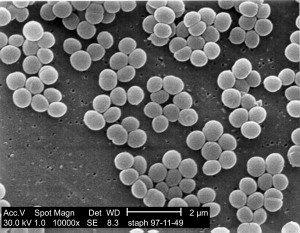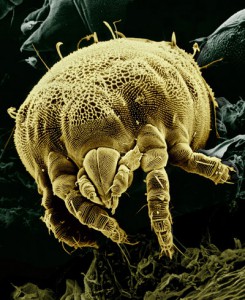What is a Microbe?
Microbes are those organisms that are microscopic and include some of the eukayotes (protist, fungi, algae, and microscopic invertebrates) and all prokaryotes (bacteria and archaea). Viruses are also included in the microbes, but we are not going to cover these fascinating entities in this module. For more information on viruses, you can visit the Wikipedia entry on viruses.

Figure 3.22: An example of a microbe, Staphylococcus aureus bacteria, the most common cause of staph infections, is seen here magnified about 10,000 times.
Image from URL: http://en.wikipedia.org/wiki/Microorganism
There are far more microbial cells on earth than plants and animals. In fact, there are more bacterial cells in a human being than human cells. Amazing, isn’t it! More than 500 different species of bacteria exist in our bodies, making up more than 100 trillion cells. Because our bodies are made of only some several trillion human cells, we are outnumbered (~10 to one!) by the aliens. It follows that most of the genes in our bodies are from bacteria, too.”
Now, for the first time, a team of researchers from the University of Georgia has made a direct estimate of the total number of bacteria on Earth and the number makes the globe’s human population look downright puny:
5,000,000,000,000,000,000,000,000,000,000
That’s “five nonillion” bacteria. For comparison’s sake, the human popluation on Earth, about six billion, looks like this:
6,000,000,000

Figure 3.23: A microscopic mite, Lorryia formosa, commonly found on citrus plants and here shown among fungi, is an example of a microbe from the animal kingdom, sometimes called microfauna.
Image from URL: http://en.wikipedia.org/wiki/Microorganism
So, what does 10E30 mean? How can we wrap our heads around it, and get our students to do the same? 10E30 equals:
As many milliliters of water as pass through the human intestines of the entire world population daily at the rate of 9 liters/day for 5 trillion years.
As many seconds as if the entire world population counted 1 number per second for 5 trillion years.
As many dollars that it would take for the entire world population to pay back the national debt 25 billion times.
It is important to keep in mind that although we and students often equate microbes and “germs,” most microbes are in no way involved in infection and diseases.